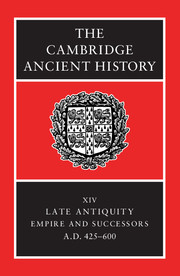Book contents
- Frontmatter
- PART I CHRONOLOGICAL OVERVIEW
- PART II GOVERNMENT AND INSTITUTIONS
- PART III EAST AND WEST: ECONOMY AND SOCIETY
- PART IV THE PROVINCES AND THE NON-ROMAN WORLD
- PART V RELIGION AND CULTURE
- 24 The organization of the church
- 25 Monasticism
- 26 Holy Men
- 27 The definition and enforcement of orthodoxy
- 28 Philosophy and philosophical schools
- 29 Education in the Roman empire
- 30 The visual arts
- 31 Building and architecture
- Conclusion
- Chronological Table
- BIBLIOGRAPHY
- Index
- References
24 - The organization of the church
from PART V - RELIGION AND CULTURE
Published online by Cambridge University Press: 28 March 2008
- Frontmatter
- PART I CHRONOLOGICAL OVERVIEW
- PART II GOVERNMENT AND INSTITUTIONS
- PART III EAST AND WEST: ECONOMY AND SOCIETY
- PART IV THE PROVINCES AND THE NON-ROMAN WORLD
- PART V RELIGION AND CULTURE
- 24 The organization of the church
- 25 Monasticism
- 26 Holy Men
- 27 The definition and enforcement of orthodoxy
- 28 Philosophy and philosophical schools
- 29 Education in the Roman empire
- 30 The visual arts
- 31 Building and architecture
- Conclusion
- Chronological Table
- BIBLIOGRAPHY
- Index
- References
Summary
BISHOPS AND PATRIARCHS
The fifth-century church inherited an organization matching that of the empire. Each community usually had its bishop, though increasingly presbyters or sometimes deacons deputized for the bishop in governing congregations. Above the local bishop stood the bishop of the metropolis, the metropolian (μητροπολιτης) whose position had been codified at Nicaea in 325. Superior to the metropolitan, the city which was the centre of an imperial diocese (επαρχια) attained comparable status in the church, and its bishop was called ‘archbishop’ (αρχιεπισκοπος) This term was frequently used of the bishops of Rome, Alexandria and Antioch at the Council of Ephesus in 431, the same sees which had been named as exercising territorial superiority in the canons of Nicaea in 325. The term ‘archbishop’ was limited to those of such standing till about 500. After that it is more widely used, first of metropolitans, then of others whose independence was being asserted. The term ‘patriarch’ (πατριαρχης) then began to be applied to the bishops of the greater sees. ‘Patriarch’ was first used of the ancient biblical figures, and had been adopted for leading officers by the Jewish communities before Constantine’s time. Its rare use for Christian figures began to be extended to the superior bishops in documents associated with the Council of Chalcedon in 451. That council also specified that the metropolitan bishops of the imperial dioceses of Pontus, Asia and Thrace should be ordained by the bishop of Constantinople; thus the metropolitans of Cappadocian Caesarea, Ephesus and Philippopolis, who were to ordain bishops in their respective imperial provinces and any pendent sees among the barbarians, were declared subordinate to the capital.
- Type
- Chapter
- Information
- The Cambridge Ancient History , pp. 731 - 744Publisher: Cambridge University PressPrint publication year: 2001

